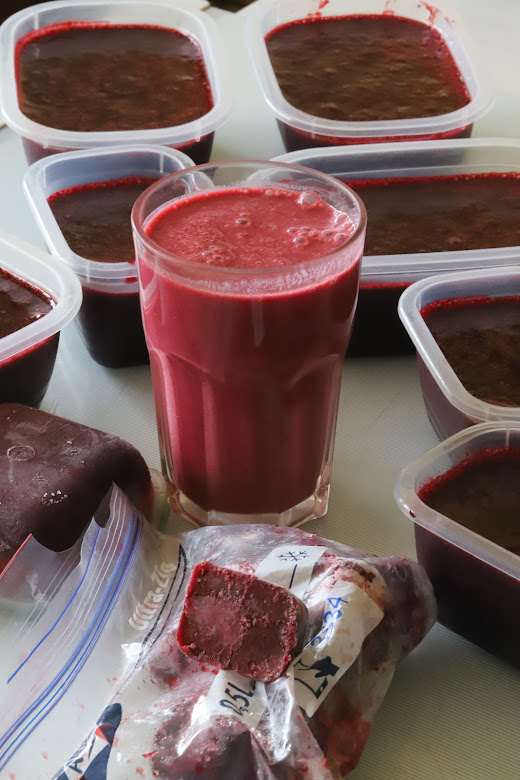Our cultivar is thornless which makes harvesting a cinch.
Though consistently watered and pruned, I yet have fertilised it in the ten years we have been here. I am not sure if I ever want to as its largesse is already a challenge to keep on top of via processing. Pruning is a simple job of keeping the new canes which spring up during summer not much longer than ninety centimetres (three feet) and its lateral branches approximately thirty centimetres (one foot) in length. After all the berries are picked, then the canes that sprung up last summer and carried the present harvest will be clipped off at ground level. In the below photo, the new cane on the left which will bear fruit next season has been trimmed; the older cane, once all its berries have been plucked, will be removed completely.
A ripe berry will have plump, individual drupelets. If they ripen too much, their fibrous centres will be replaced with juice which can be seen oozing among the drupelets. The juice can become slightly fermented; when popping one such berry into your mouth, it's like taking a tiny sip of blackberry wine.
A Foley mill made short order of all those berries.
Icing sugar was added to the sieved, mashed, fresh berries, better known as coulis, until it reached the desired sweetness which isn't too much as additional sweetening can be added if desired. It is the uncooked state of the fruit that gives such a burst of flavour as contrasted to a puree which is sieved, mashed, cooked fruit.
Those ten litres of blackberries became three litres of coulis. Besides ladling it into variously sized containers, ice cube trays were filled also. Once frozen, the cubes were placed into a ziplock bag. The luscious coulis, once defrosted or if your mixer is powerful enough, throw in a few blackberry ice cubes instead, is used in smoothies (the one below has yogurt, water, coulis, maple syrup, and powdered ginger) . . .
. . . and parfaits (the one below has a layer of yogurt and one of creme fraiche, two of coulis, and a topping of yogurt marbled with coulis sprinkled with icing sugar) . . .
. . . not to mention a dessert sauce, as in the below photo, smothering coffee ice cream. Coulis can drench cake/muffins, fill doughnuts/hand pies/cake rolls, and made into blackberry butter (reduce either over a low flame or in an oven until very thick). Versatility, thy name is blackberry coulis.
À la prochaine!









No comments:
Post a Comment
Note: only a member of this blog may post a comment.